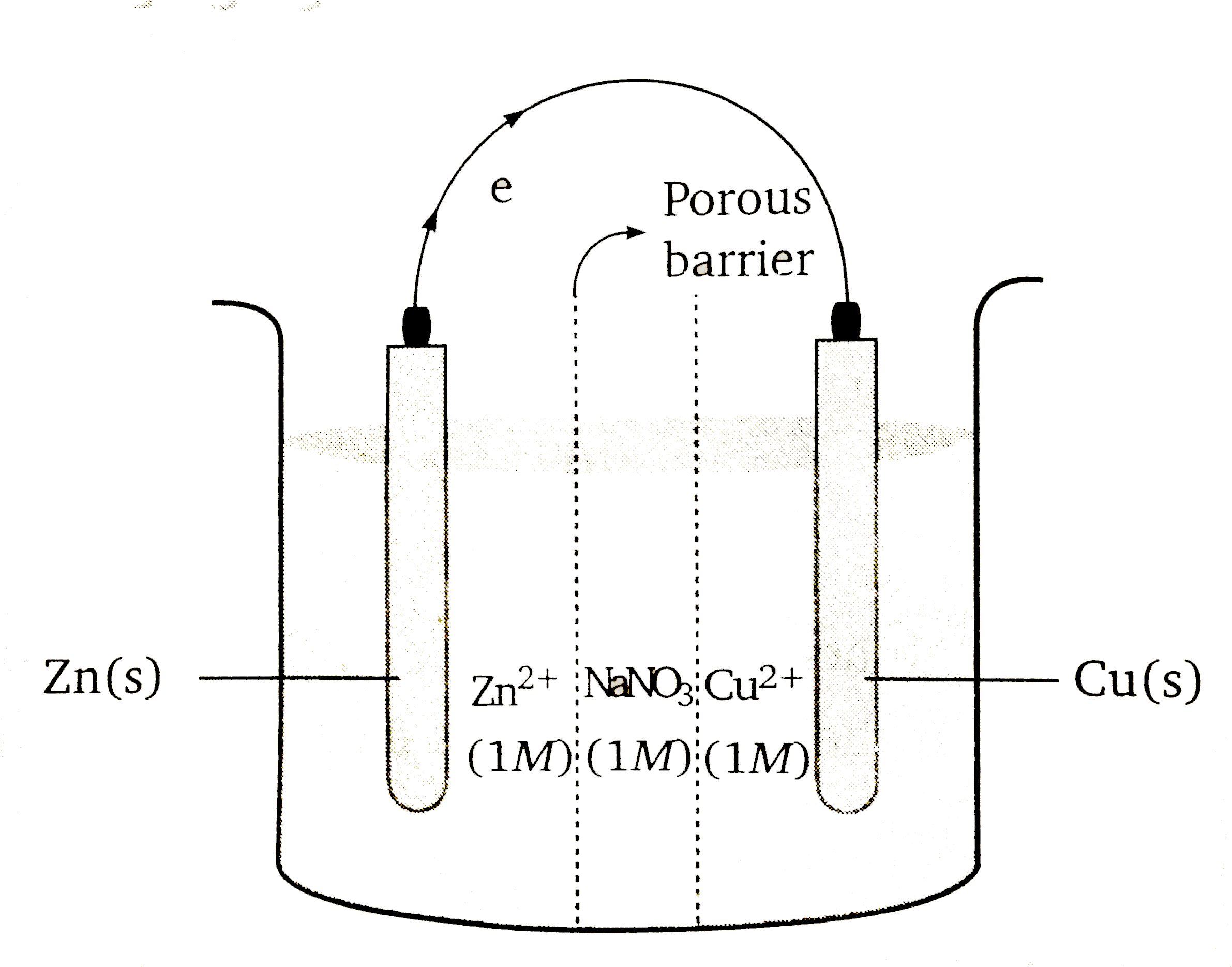A dilute solution of KCl was placed between two Pt electrodes 10cm apart across which a potential difference of 10 volt was applied. Which is /are correct statement (Given: molar conductivity of K+ at infinite dilution is 96.5 Scm2mol−1
a) "Ionic mobility of "
K+ " is " 10−3cm2sec−1volt−1
b) "The speed of" K+ is 10−3cmsec−1
c) "Distance traveled by"
K+ in 5×103 sec is
5cm
d) "The potential gradient is 1.0 volt" cm−1
Solution in Punjabi
Ionic mobility of K+ is 10−3cm2sec−1volt−1
The speed of K+ is 10−3 cm sec−1
Distance travelled by K+ in 5×103 sec is 5cm
The potential gradient is 1.0 volt cm−1
The correct Answer is:A, B, C, D
Step by step video & image solution for A dilute solution of KCl was placed between two Pt electrodes 10cm apart across which a potential difference of 10 volt was applied. Which is /are correct statement (Given: molar conductivity of K^(+) at infinite dilution is 96.5 Scm^2mol^(-1) a) "Ionic mobility of " K^(+) " is " 10^(-3)cm^(2)sec^(-1)"volt"^(-1) b) "The speed of" K^(+) is 10^(-3)cmsec^(-1) c) "Distance traveled by" K^(+) in 5xx10^3 sec is 5cm d) "The potential gradient is 1.0 volt" cm^(-1) by Chemistry experts to help you in doubts & scoring excellent marks in Class 11 exams.
Updated on:21/07/2023Topper's Solved these Questions
- ELECTROCHEMISTRYBOOK - NARENDRA AWASTHICHAPTER - ELECTROCHEMISTRYEXERCISE - Level 3 - Match The Column
1 Videos
- ELECTROCHEMISTRYBOOK - NARENDRA AWASTHICHAPTER - ELECTROCHEMISTRYEXERCISE - Level 3 - Subjective Problems
1 Videos
- ELECTROCHEMISTRYBOOK - NARENDRA AWASTHICHAPTER - ELECTROCHEMISTRYEXERCISE - Level 3 - Passage
5 Videos
- DILUTE SOLUTIONBOOK - NARENDRA AWASTHICHAPTER - DILUTE SOLUTIONEXERCISE - Level 3 - Match The Column
1 Videos
- GASEOUS STATEBOOK - NARENDRA AWASTHICHAPTER - GASEOUS STATEEXERCISE - Level 3 - Subjective Problems
1 Videos
Similar Questions
Column-1 and column-II contains four entries each. Entries of column-I are to be matched with some entries of column-II .One or more than one entries of column-I may have the matching with the same entries of column-II

View SolutionCalculate the oxidation state of nitrogen ( N ) in NO2
View Solution
A Galvanic cell consits of three compartment as shown in figure. The first compartment contain ZnSO4(1M) and III compartment contain CuSO4(1M). The mid compartment contain NaNO3 (1M). Each compartment contain 1L solution:
E∘Zn2+/Zn=−0.76, E∘Cu2+/Cu=+0.34,
The concertation of Zn2+ in first compartment after passage of 0.1 F charge will be:
View SolutionColumn -I and Column -II contain four entries each. Entries of column-I are to be matched with some entries of column-II. One or more than one entries of column-I may have the matching with the same entries of column-II.

View SolutionOne mole of an ideal gas undergoes a change of state (2.0) atm, 3.0 L) to (2.0 atm, 7.0 L) with a change in internal energy (ΔU)=30 L-atm. The change in enthalpy (ΔH) of the process in L-atm :
View SolutionA dilute aqueous solution of KCIwas placed between two electrodes 10 cm apart, across which a potential of 6 volt was applied. How far would the K+ ion move in 2 hours at 25∘C? Ionic conductance of K+ ion at infinite dilution at 25∘C is 73.52ohm−1cm2mole−1?
View Solutionmolar conductivity (bidwedge_m) is defined as conducting power of the ions producedd by 1 mole of an electrolyte in a solution. bidwedge_m=K/C Where k is conductivity (Scm^2mol^(-1)) and C is molar concentration (in mol//cm^3) The molar conductivity of 0.04 M solution of MgCl_2 is 200 Scm^3mol^(-1) at 298 k. A cell with electrodes that are 2.0 cm^2 in surface area and 0.50cm apart is filled with MgCl_2 solution. Conductance of MgCl_2 solution is :
View Solutionmolar conductivity(b_m) is defined as conducting power of the ions producedd by 1 mole of an electrolyte in a solution. b_m=KC Where k is conductivity (Scm2mol−1) and C is molar concentration (∈mol/cm3)
The molar conductivity of 0.04 M solution of MgCl2 is 200 Scm3mol−1 at 298 k. A cell with electrodes that are 2.0cm2 in surface area and 0.50cm apart is filled with MgCl2 solution
How much current will flow when the potential difference between the two electrodes is 5.0V?
View SolutionA dilute solution of KCl was placed between two Pt electrodes 10cm apart across which a potential difference of 10 volt was applied. Which is /are correct statement (Given: molar conductivity of K+ at infinite dilution is 96.5 Scm^2mol^(-1))
View SolutionThe molar ionic conductance at infinite dilution of K^(+) and SO_(4)^(2-) are 73.5 and 160 Scm^(2)mol^(-1) respectively.The molar conductance of solution of K_(2)SO_(4) at infinite dilution will be
View SolutionA dilute solution of KCl was placed between two platinum electrodes, 12 cm apart, across which a potential of 1.93 volts was applied. How far (in m) would the K + ion move in 20 h at 25∘C ? Ionic conductance of K + ion at infinite dilution at 25∘C is 7.5×10−3 moh m2mol−1 .
View SolutionAt 25∘C, the correct order of molar ionic conductances of the ions H+,Li+,Na+andK+ in infinite dilute aqueous solution is -
View SolutionThe molar conductivity of HCl, NaCl and CH_3COONa solutions at infinite dilution is 426.2,126.5 and 91.0ohm ^ (- 1) cm ^ 2mol ^ (- 1), respectively.
View SolutionThe molar conductivity of 0.04 M solution of MgCl2 is 200 Scm2mol−1 at 298 k. A cell with electrodes that are 2.0cm2 in surface area and 0.50cm apart is filled with MgCl2 solution.
Conductance of MgCl2 solution is :
View SolutionA dilute solution of KCl was placed between two Pt electrodes 10cm apart across which a potential difference of 10 volt was applied. Which is /are correct statement (Given: molar conductivity of K+ at infinite dilution is 96.5Scm2mol−1
View Solution
